Mobile
-
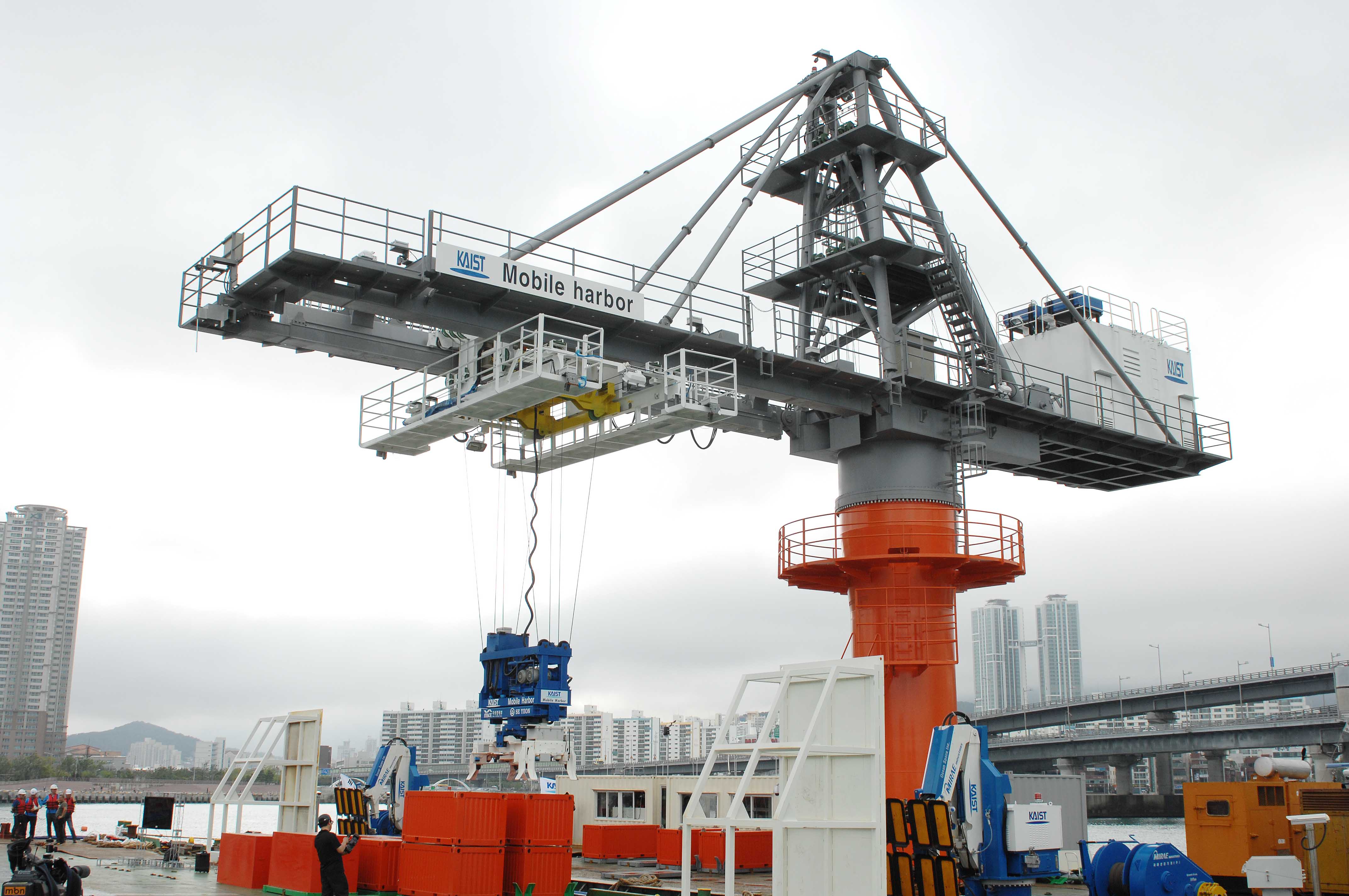 KAIST Successfully Demonstrates Mobile Harbor in the Open Sea
Busan, South Korea—Large container ships are no longer required to come into ports to transport cargo, as KAIST has developed an innovative technology that will transform the paradigm of today’s cargo handling operations. A Mobile Harbor is a vessel that carries a large stabilized crane with a smart spreader and multistage trolley system, enabling the loading and unloading of ship cargo on the wavy open sea. Following a successful docking of two vessels at sea in April of this year, KAIST conducted a full scope of Mobile Harbor operations in the inner sea of Busan, South Korea, on June 29, 2011.
Initiated in 2009, the Mobile Harbor (MH) is one of the university’s flagship research projects, which aims to provide a new growth engine that will lead the Korean economy to the next level of advancement, and to develop green technology through multidisciplinary and convergence research. The idea of MH came to light when thinking outside the box (why can’t a harbor go out to meet a ship on voyage and retrieve goods instead of ships coming into the harbor?) to improve problems relating to the current maritime transport system, such as port congestion, environmental issues caused by heavy sea transport, increased demand for supersized container ships, and the need for port construction and expansion.
The essential technology to establish a Mobile Harbor is a docking system and crane system that can overcome the obstacles imposed by the sea, i.e., waves and wind. Connecting two operating vessels of different sizes in the unpredictable and ever-changing environment of the sea was regarded as “impossible” and had never been tried before, but, on April 26, 2011, KAIST successfully demonstrated the technology to moor vessels safely and securely.
The Mobile Harbor has a unique way of mooring vessels that are anchored at sea: its flexibly designed robot arms with a square-shape vacuum suction pad at the tip reach out and attach to the hull of a container ship for docking. Each robot arm is connected to a cable and winch that further add stability to the Mobile Harbor. Foam-filled fenders are placed between the Mobile Harbor and the container ship, thereby maintaining a safe distance to prevent collisions.
The crane system consists of a multistage trolley, smart spreader, and tension controller, all of which provide the crane with functionality and stability to move around cargo containers in the sea. The crane system also has various sensors like cameras and laser scanners, and therefore, it can gauge the movement of the spreader and ships as well as trace a target container in real time. As a result, the spreader, a container grabbing device, is free from the swing motions when lifting and putting down cargo and grabs a target container safely in the wavy open sea.
During today’s at-sea demonstration in Busan, a research team from the KAIST Mobile Harbor Center docked a Mobile Harbor (a barge ship) right next to a container vessel (the other barge ship) and repeated freight transport operations between the two ships, presenting the great potential to commercialize the Mobile Harbor technology.
The project has been implemented in collaboration with industries, research institutes, and universities in such fields as mechanical engineering, robotics, automation engineering, and ocean systems engineering. The demonstration proceeded with a wide range of participants including researchers, engineers, government officials, and entrepreneurs from Korea and around the world.
Byung-Man Kwak, Director of the KAIST Mobile Harbor Center, explained his feelings on the successful demonstration:
“It’s been a remarkable journey to develop a Mobile Harbor from scratch, and I’m genuinely thrilled to showcase what we have accomplished so far. Today’s demonstration of Mobile Harbor’s core technologies will really change the face of our maritime transportation system. We will be able to deliver more goods to global markets and consumers via sea route, not necessarily building more ports or expanding the existing harbors. KAIST’s Mobile Harbor will also significantly cut down the high cost related to overland transportation of cargo and in return, contribute to the reduction of carbon emission.”
The Center has received much interest in possible market migration and broader application of the Mobile Harbor from businesses and organizations, e.g., US Office of Naval Research, King Fahd University of Petroleum and Minerals, Saudi Aramco, POSCO, and the Korean Navy.
2011.07.06 View 18336
KAIST Successfully Demonstrates Mobile Harbor in the Open Sea
Busan, South Korea—Large container ships are no longer required to come into ports to transport cargo, as KAIST has developed an innovative technology that will transform the paradigm of today’s cargo handling operations. A Mobile Harbor is a vessel that carries a large stabilized crane with a smart spreader and multistage trolley system, enabling the loading and unloading of ship cargo on the wavy open sea. Following a successful docking of two vessels at sea in April of this year, KAIST conducted a full scope of Mobile Harbor operations in the inner sea of Busan, South Korea, on June 29, 2011.
Initiated in 2009, the Mobile Harbor (MH) is one of the university’s flagship research projects, which aims to provide a new growth engine that will lead the Korean economy to the next level of advancement, and to develop green technology through multidisciplinary and convergence research. The idea of MH came to light when thinking outside the box (why can’t a harbor go out to meet a ship on voyage and retrieve goods instead of ships coming into the harbor?) to improve problems relating to the current maritime transport system, such as port congestion, environmental issues caused by heavy sea transport, increased demand for supersized container ships, and the need for port construction and expansion.
The essential technology to establish a Mobile Harbor is a docking system and crane system that can overcome the obstacles imposed by the sea, i.e., waves and wind. Connecting two operating vessels of different sizes in the unpredictable and ever-changing environment of the sea was regarded as “impossible” and had never been tried before, but, on April 26, 2011, KAIST successfully demonstrated the technology to moor vessels safely and securely.
The Mobile Harbor has a unique way of mooring vessels that are anchored at sea: its flexibly designed robot arms with a square-shape vacuum suction pad at the tip reach out and attach to the hull of a container ship for docking. Each robot arm is connected to a cable and winch that further add stability to the Mobile Harbor. Foam-filled fenders are placed between the Mobile Harbor and the container ship, thereby maintaining a safe distance to prevent collisions.
The crane system consists of a multistage trolley, smart spreader, and tension controller, all of which provide the crane with functionality and stability to move around cargo containers in the sea. The crane system also has various sensors like cameras and laser scanners, and therefore, it can gauge the movement of the spreader and ships as well as trace a target container in real time. As a result, the spreader, a container grabbing device, is free from the swing motions when lifting and putting down cargo and grabs a target container safely in the wavy open sea.
During today’s at-sea demonstration in Busan, a research team from the KAIST Mobile Harbor Center docked a Mobile Harbor (a barge ship) right next to a container vessel (the other barge ship) and repeated freight transport operations between the two ships, presenting the great potential to commercialize the Mobile Harbor technology.
The project has been implemented in collaboration with industries, research institutes, and universities in such fields as mechanical engineering, robotics, automation engineering, and ocean systems engineering. The demonstration proceeded with a wide range of participants including researchers, engineers, government officials, and entrepreneurs from Korea and around the world.
Byung-Man Kwak, Director of the KAIST Mobile Harbor Center, explained his feelings on the successful demonstration:
“It’s been a remarkable journey to develop a Mobile Harbor from scratch, and I’m genuinely thrilled to showcase what we have accomplished so far. Today’s demonstration of Mobile Harbor’s core technologies will really change the face of our maritime transportation system. We will be able to deliver more goods to global markets and consumers via sea route, not necessarily building more ports or expanding the existing harbors. KAIST’s Mobile Harbor will also significantly cut down the high cost related to overland transportation of cargo and in return, contribute to the reduction of carbon emission.”
The Center has received much interest in possible market migration and broader application of the Mobile Harbor from businesses and organizations, e.g., US Office of Naval Research, King Fahd University of Petroleum and Minerals, Saudi Aramco, POSCO, and the Korean Navy.
2011.07.06 View 18336 -
 Professor Choi Han Lim receives Automatica Applications Paper Price
Professor Choi Han Lim of the Department of Aerospace received ‘Automatica Applications Paper Prize’ for the first time ever for a Korean.
Professor Choi published a paper in the Automatica magazine with the topic of ‘Continuous Trajectory Planning of Mobile Sensors for Informative Forecasting’.
Professor Choi dealt with most efficient measuring methods for mobile sensor platforms thereby improving the performance of anticipating environmental changes and proposed key theories for problem solving and also an efficient algorithm.
The research was conducted in cooperation with MIT Department of Aerospace Professor Jonathan How with the support of the National Science Foundation.
Automatica
Journal published by the International Federation of Automatic Control and has been awarding the Automatica Paper Prize every three years.
2011.05.31 View 9708
Professor Choi Han Lim receives Automatica Applications Paper Price
Professor Choi Han Lim of the Department of Aerospace received ‘Automatica Applications Paper Prize’ for the first time ever for a Korean.
Professor Choi published a paper in the Automatica magazine with the topic of ‘Continuous Trajectory Planning of Mobile Sensors for Informative Forecasting’.
Professor Choi dealt with most efficient measuring methods for mobile sensor platforms thereby improving the performance of anticipating environmental changes and proposed key theories for problem solving and also an efficient algorithm.
The research was conducted in cooperation with MIT Department of Aerospace Professor Jonathan How with the support of the National Science Foundation.
Automatica
Journal published by the International Federation of Automatic Control and has been awarding the Automatica Paper Prize every three years.
2011.05.31 View 9708 -
 Korea Times on Mobile Harbor, May 29, 2011
The Korea Times mentioned KAIST’s Mobile Harbor in its recent article entitled “Korea-UAE partnership making big strides” dated May 29, 2011. While talking about the ongoing partnership efforts being made between Korea and the United Arab Emirates (UAE) in many areas of industry, economy, and education, the paper picked the mobile harbor as an example of Korea’s green growth technology being developed by KAIST. For the article, please copy and paste the link.
http://www.koreatimes.co.kr/www/news/include/print.asp?newsIdx=87873
2011.05.30 View 12138
Korea Times on Mobile Harbor, May 29, 2011
The Korea Times mentioned KAIST’s Mobile Harbor in its recent article entitled “Korea-UAE partnership making big strides” dated May 29, 2011. While talking about the ongoing partnership efforts being made between Korea and the United Arab Emirates (UAE) in many areas of industry, economy, and education, the paper picked the mobile harbor as an example of Korea’s green growth technology being developed by KAIST. For the article, please copy and paste the link.
http://www.koreatimes.co.kr/www/news/include/print.asp?newsIdx=87873
2011.05.30 View 12138 -
 World?'s First Automated Maritime-Docking between Naval Vessels
KAIST demonstrated the technology that allows automated maritime docking between naval vessels on the 26th of April at Busan, Korea.
The docking technology is seen as one of the key components for the mobile harbor as it prevents collision between two naval vessels upon docking. It was recognized as an important technology worldwide, but its technological limitations made it hard to commercialize.
The demonstrated included approaching a barge next to a cargo vessel, performing automated docking, and maintaining the docking and solutions in the advent of an emergency.
The mobile harbor is, in essence, is a ‘moving port’ and the automated docking technology is imperative to commercialize the mobile harbor. In order for a large container ship to unload cargo, the mobile harbor needs to approach the container ship and dock onto the side of the ship.
The technology required to keep the two moving vessels docked, out at sea, in an efficient and safe manner, is daunting. The conventional method involved sailors tying the two vessels together with rope which made it time consuming and hard to react quickly in emergency situations.
The KAIST mobile harbor research team developed the docking technology with ‘Mirae Industrial Machine’ Maritime Corporation, and ‘Ocean Space’. The mobile harbor will allow two vessels to perform loading and unloading of cargo regardless of wind and current, using robotic arms, vacuum attachment pads, wench, and are a complex, integrated system.
KAIST is planning on having a demonstration that encompasses all the technology required for mobile harbor: from the docking technology to the stabilizing crane technology.
Advancements made by KAIST are expected to speed up the commercialization and the real life application of mobile harbor.
2011.05.11 View 11588
World?'s First Automated Maritime-Docking between Naval Vessels
KAIST demonstrated the technology that allows automated maritime docking between naval vessels on the 26th of April at Busan, Korea.
The docking technology is seen as one of the key components for the mobile harbor as it prevents collision between two naval vessels upon docking. It was recognized as an important technology worldwide, but its technological limitations made it hard to commercialize.
The demonstrated included approaching a barge next to a cargo vessel, performing automated docking, and maintaining the docking and solutions in the advent of an emergency.
The mobile harbor is, in essence, is a ‘moving port’ and the automated docking technology is imperative to commercialize the mobile harbor. In order for a large container ship to unload cargo, the mobile harbor needs to approach the container ship and dock onto the side of the ship.
The technology required to keep the two moving vessels docked, out at sea, in an efficient and safe manner, is daunting. The conventional method involved sailors tying the two vessels together with rope which made it time consuming and hard to react quickly in emergency situations.
The KAIST mobile harbor research team developed the docking technology with ‘Mirae Industrial Machine’ Maritime Corporation, and ‘Ocean Space’. The mobile harbor will allow two vessels to perform loading and unloading of cargo regardless of wind and current, using robotic arms, vacuum attachment pads, wench, and are a complex, integrated system.
KAIST is planning on having a demonstration that encompasses all the technology required for mobile harbor: from the docking technology to the stabilizing crane technology.
Advancements made by KAIST are expected to speed up the commercialization and the real life application of mobile harbor.
2011.05.11 View 11588 -
 KAIST Mobile Homepage Open
KAIST opened a mobile homepage (http://m.kaist.ac.kr) in order to provide an improved level of service to the public and KAIST family members.
The mobile homepage is made up of: notifications, KAIST news, cultural program guide, introduction of KAIST, campus map, undergraduate information, admission information, KAIST public relations pages.
Especially going into the KAIST public relations page and following ‘With-KAIST’ on twitter allows access to live feed of KAIST news and will be a good means of communications with the school and KAIST family members. This service was initiated on June of last year and has 559 followers.
The mobile homepage can be accessed on any smart phones like iPhone, Galaxy, etc.
Cho Joon Hyung IT Development Manger who was in charge of the development of the mobile homepage commented, “the mobile homepage was developed to meet the demand from smart phone users. Users will be able to access school related information heightening information accessibility”.
2011.02.21 View 9065
KAIST Mobile Homepage Open
KAIST opened a mobile homepage (http://m.kaist.ac.kr) in order to provide an improved level of service to the public and KAIST family members.
The mobile homepage is made up of: notifications, KAIST news, cultural program guide, introduction of KAIST, campus map, undergraduate information, admission information, KAIST public relations pages.
Especially going into the KAIST public relations page and following ‘With-KAIST’ on twitter allows access to live feed of KAIST news and will be a good means of communications with the school and KAIST family members. This service was initiated on June of last year and has 559 followers.
The mobile homepage can be accessed on any smart phones like iPhone, Galaxy, etc.
Cho Joon Hyung IT Development Manger who was in charge of the development of the mobile homepage commented, “the mobile homepage was developed to meet the demand from smart phone users. Users will be able to access school related information heightening information accessibility”.
2011.02.21 View 9065 -
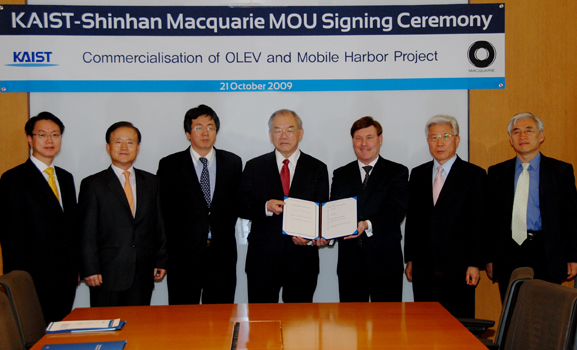 KAIST Signs MOU with Macquarie for Cooperation in Green Growth Projects
KAIST and Shinhan Macquarie Financial Advisory Co. have reached an agreement for cooperation in the development and commercialization of the KAIST-led two national green growth projects, On-line Electric Vehicle (OLEV) and Mobile Harbor (MH) programs, university authorities said.
KAIST President Nam-Pyo Suh signed a memorandum of understanding with John Walker, Chairman of Macquarie Group of Companies in Korea, and Woo-Gon Hwang, Representative Director of Shinhan Macquarie Financial Advisory Co. on Wednesday, Oct. 21.
Under the agreement, KAIST and Macquarie will cooperate in developing an optimal business structure for a rapid commercialization of OLEV and MH. Specifically, Shinhan Macquarie Financial Advisory will provide financial advice, including basis financial analysis, potential investor inducement and feasibility analysis of the projects.
Shinhan Macquarie Financial Advisory Co. is a joint venture between Shinhan Financial Group of Korea and the Australia-based Macquarie Bank Group which provides global investment banking and diversified financial services.
KAIST"s OLEV is a project to develop a new growth engine for Korea and lead the future of global automotive industry. It is an entirely new concept: the electric vehicle picks up power from underground power supplier lines, while either running or standing, through the non-contact magnetic charging method.
The MH program is designed to develop a system that can load/unload containers from a containership in the open sea and deliver them to their destinations at the harbor.
The Korean government has included these KAIST projects, which both are great technical and engineering challenges, in the nation"s sustainable growth programs, providing substantial research grants. KAIST offers its advanced research capabilities for the nation"s efforts to achieve efficient, environment-friendly utilization of resources as new growth engines that spur the development of related industries and explore global markets.
2009.10.22 View 16183
KAIST Signs MOU with Macquarie for Cooperation in Green Growth Projects
KAIST and Shinhan Macquarie Financial Advisory Co. have reached an agreement for cooperation in the development and commercialization of the KAIST-led two national green growth projects, On-line Electric Vehicle (OLEV) and Mobile Harbor (MH) programs, university authorities said.
KAIST President Nam-Pyo Suh signed a memorandum of understanding with John Walker, Chairman of Macquarie Group of Companies in Korea, and Woo-Gon Hwang, Representative Director of Shinhan Macquarie Financial Advisory Co. on Wednesday, Oct. 21.
Under the agreement, KAIST and Macquarie will cooperate in developing an optimal business structure for a rapid commercialization of OLEV and MH. Specifically, Shinhan Macquarie Financial Advisory will provide financial advice, including basis financial analysis, potential investor inducement and feasibility analysis of the projects.
Shinhan Macquarie Financial Advisory Co. is a joint venture between Shinhan Financial Group of Korea and the Australia-based Macquarie Bank Group which provides global investment banking and diversified financial services.
KAIST"s OLEV is a project to develop a new growth engine for Korea and lead the future of global automotive industry. It is an entirely new concept: the electric vehicle picks up power from underground power supplier lines, while either running or standing, through the non-contact magnetic charging method.
The MH program is designed to develop a system that can load/unload containers from a containership in the open sea and deliver them to their destinations at the harbor.
The Korean government has included these KAIST projects, which both are great technical and engineering challenges, in the nation"s sustainable growth programs, providing substantial research grants. KAIST offers its advanced research capabilities for the nation"s efforts to achieve efficient, environment-friendly utilization of resources as new growth engines that spur the development of related industries and explore global markets.
2009.10.22 View 16183 -
 KAIST Wins Official Membership of ERCIS
The Center for Software Policy Study of KAIST has recently become the 20th official member of the European Research Center for Information Systems (ERCIS) by signing an agreement with the organization, university authorities said on Thursday (Oct. 22).
The ERCIS is a network of scientists who conduct cooperative research in the field of integrated information systems development and organizational design. The Center undertakes interdisciplinary research with the participation of computer scientists, business management experts and law scholars.
KAIST will seek to activate exchange of professors, research fellows and graduate students with ERCIS members, as well as implementing credit exchange and dual degree programs.
ERCIS, was first organized by the German state of North Rhine-Westfahlia, is currently managed by the University of Muenster, a global leader in the field of information systems and business administration. Joining the ERCIS are one university each from New Zealand, the Netherlands, Germany, Russia, Liechtenstein, the United States, Switzerland, Spain, Slovenia, Ireland, Britain, Austria, Italy, the Czech Republic, Poland, France, Finland and Australia.
KAIST"s Center for Software Policy Study is currently preparing for the establishment of a support system for developers of the mobile application software as part of the EUREKA project. Korea is playing a leading role in this project on the strength of its competitiveness in the mobile phone industry.
EUREKA is a pan-European intergovernmental network for market-oriented, industrial R&D aimed at enhancing European competitiveness through its support to businesses, research centers and universities who carry out pan-European projects to develop innovative products, processes and services.
2009.10.22 View 15276
KAIST Wins Official Membership of ERCIS
The Center for Software Policy Study of KAIST has recently become the 20th official member of the European Research Center for Information Systems (ERCIS) by signing an agreement with the organization, university authorities said on Thursday (Oct. 22).
The ERCIS is a network of scientists who conduct cooperative research in the field of integrated information systems development and organizational design. The Center undertakes interdisciplinary research with the participation of computer scientists, business management experts and law scholars.
KAIST will seek to activate exchange of professors, research fellows and graduate students with ERCIS members, as well as implementing credit exchange and dual degree programs.
ERCIS, was first organized by the German state of North Rhine-Westfahlia, is currently managed by the University of Muenster, a global leader in the field of information systems and business administration. Joining the ERCIS are one university each from New Zealand, the Netherlands, Germany, Russia, Liechtenstein, the United States, Switzerland, Spain, Slovenia, Ireland, Britain, Austria, Italy, the Czech Republic, Poland, France, Finland and Australia.
KAIST"s Center for Software Policy Study is currently preparing for the establishment of a support system for developers of the mobile application software as part of the EUREKA project. Korea is playing a leading role in this project on the strength of its competitiveness in the mobile phone industry.
EUREKA is a pan-European intergovernmental network for market-oriented, industrial R&D aimed at enhancing European competitiveness through its support to businesses, research centers and universities who carry out pan-European projects to develop innovative products, processes and services.
2009.10.22 View 15276 -
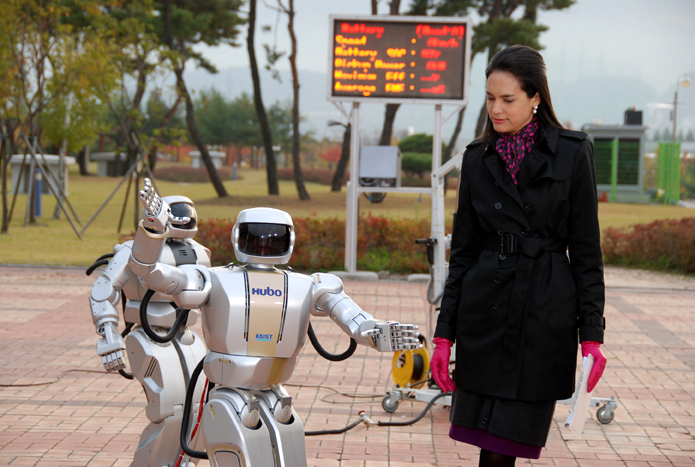 National Green Growth Project, Online Electric Vehicle, Showcased on CNN
KAIST"s green growth technologies were broadcast live on U.S. cable news network CNN from 8 a.m. to 9:30 a.m. Oct. 21.
The program was part of CNN"s week-long series, titled "Eye on South Korea," focusing on how Korea is working to become a brand leader on an international scale and how the nation is recovering from the global economic recession.
During the broadcast, award-winning CNN anchor and correspondent Kristie Lu Stout interviewed KAIST President Nam-Pyo Suh to hear about KAIST-developed two green-growth projects, On-Line Electric Car and Mobile Harbor. KAIST"s humanoid robot Hubo was also showcased.
Live broadcasts of "Eye on South Korea" aired from Oct. 21 through 23.
2009.10.21 View 15689
National Green Growth Project, Online Electric Vehicle, Showcased on CNN
KAIST"s green growth technologies were broadcast live on U.S. cable news network CNN from 8 a.m. to 9:30 a.m. Oct. 21.
The program was part of CNN"s week-long series, titled "Eye on South Korea," focusing on how Korea is working to become a brand leader on an international scale and how the nation is recovering from the global economic recession.
During the broadcast, award-winning CNN anchor and correspondent Kristie Lu Stout interviewed KAIST President Nam-Pyo Suh to hear about KAIST-developed two green-growth projects, On-Line Electric Car and Mobile Harbor. KAIST"s humanoid robot Hubo was also showcased.
Live broadcasts of "Eye on South Korea" aired from Oct. 21 through 23.
2009.10.21 View 15689 -
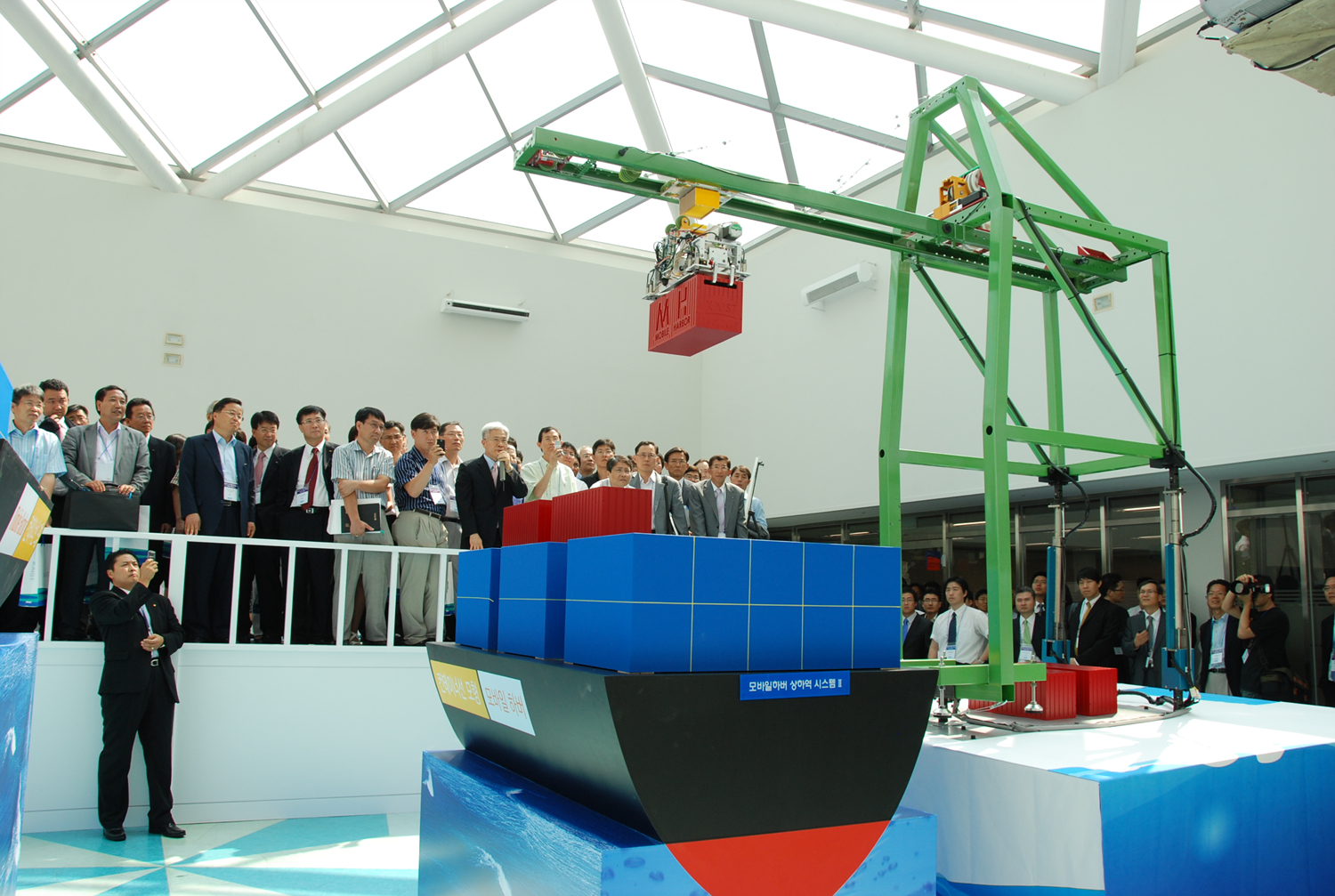 KAIST's Mobile Harbor Program Attracts Two Corporate Investments
KAIST-developed Mobile Harbor Program has attracted investments from Korea"s two big-name industrial corporations, university authorities said on Monday (Oct. 19).
KAIST has recently signed an agreement with Hyundai Wia Corp., a machine parts supplier, to collaborate in the researches of the mobile harbor programs and commercialization. Under the agreement, Hyundai WIA will invest a total of 7.5 billion won in the program for two years starting from January 2010.
KAIST has also received a letter of intent from the Daewoo Shipbuilding & Marine Engineering Co. on investing 20 billion won in the commercialization of the project.
The Mobile Harbor Program is designed to create mobile units that can go out to the ship which are anchored off-shore and unload the cargo and take it to where it is needed. It is aimed at overcoming the shortcomings of the current maritime container transportation systems. Container ships are getting larger and larger, requiring deep waters, large and complex loading and unloading systems, and major investments in facilities.
Prof. Byung-Man Kwak, leader of the program"s R&D team, said: "With the investment from two global industrial companies, the program has gained a crucial momentum. The development of the program is expected to help Korea to become a global leader in marine transportation and maintain its supremacy in shipbuilding."
2009.10.20 View 18321
KAIST's Mobile Harbor Program Attracts Two Corporate Investments
KAIST-developed Mobile Harbor Program has attracted investments from Korea"s two big-name industrial corporations, university authorities said on Monday (Oct. 19).
KAIST has recently signed an agreement with Hyundai Wia Corp., a machine parts supplier, to collaborate in the researches of the mobile harbor programs and commercialization. Under the agreement, Hyundai WIA will invest a total of 7.5 billion won in the program for two years starting from January 2010.
KAIST has also received a letter of intent from the Daewoo Shipbuilding & Marine Engineering Co. on investing 20 billion won in the commercialization of the project.
The Mobile Harbor Program is designed to create mobile units that can go out to the ship which are anchored off-shore and unload the cargo and take it to where it is needed. It is aimed at overcoming the shortcomings of the current maritime container transportation systems. Container ships are getting larger and larger, requiring deep waters, large and complex loading and unloading systems, and major investments in facilities.
Prof. Byung-Man Kwak, leader of the program"s R&D team, said: "With the investment from two global industrial companies, the program has gained a crucial momentum. The development of the program is expected to help Korea to become a global leader in marine transportation and maintain its supremacy in shipbuilding."
2009.10.20 View 18321 -
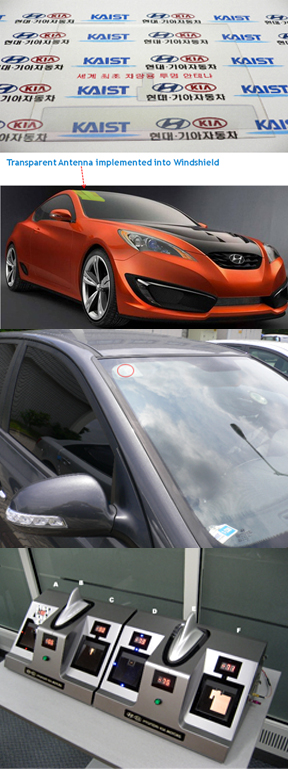 Transparent Antenna for Automobile Developed
A research team led by Prof. Jae-Woo Park of the School of Electrical Engineering & Computer Science, KAIST, developed a transparent antenna for the next-generation automobiles, university authorities said on Monday (Aug. 17).
The development was made possible through joint researches with the Hyundai-Kia Automotive Group; Winncom, a car antenna manufacturer; and a group of researchers led by Han-Ki Kim of the Department of Display Materials Engineering at Kyung Hee University in Seoul.
The transparent antennas were developed in two kinds -- one for the HSDPA (High-Speed Downlink Packet Access), a new protocol for mobile telephone data transmission, and the other for transmitting and receiving radio wave for emergency call.
Using the transparent electrically conductive film formation technology, the transparent antennas are to be mounted on the windshield of a vehicle.
"The development of transparent antenna represents a step forward for the advancement of the next-generation automotive electronic technology," said Seong-woo Kim, a senior researcher at the Hyundai-Kia Group.
2009.08.18 View 16095
Transparent Antenna for Automobile Developed
A research team led by Prof. Jae-Woo Park of the School of Electrical Engineering & Computer Science, KAIST, developed a transparent antenna for the next-generation automobiles, university authorities said on Monday (Aug. 17).
The development was made possible through joint researches with the Hyundai-Kia Automotive Group; Winncom, a car antenna manufacturer; and a group of researchers led by Han-Ki Kim of the Department of Display Materials Engineering at Kyung Hee University in Seoul.
The transparent antennas were developed in two kinds -- one for the HSDPA (High-Speed Downlink Packet Access), a new protocol for mobile telephone data transmission, and the other for transmitting and receiving radio wave for emergency call.
Using the transparent electrically conductive film formation technology, the transparent antennas are to be mounted on the windshield of a vehicle.
"The development of transparent antenna represents a step forward for the advancement of the next-generation automotive electronic technology," said Seong-woo Kim, a senior researcher at the Hyundai-Kia Group.
2009.08.18 View 16095 -
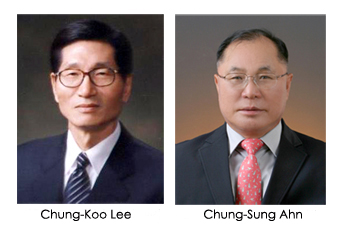 KAIST Appoints Two CEOs for Promotion of Innovative Projects
KAIST has appointed chief executive officers (CEO) for the two companies KAIST has recently established to carry out two innovative "low-carbon, green growth projects" supported by the Korean government, university authorities said on Monday (June 2).
Chung-Sung Ahn, a former executive of Hyundai Heavy Industries Co., a top shipbuilder of the world, was appointed as the CEO of the Mobile Harbor Co., and Chung-Koo Lee, a former president of Hyundai Motor Co., as CEO of the On-Line Electric Car Co.
The two companies have been newly established for the commercial operation of the mobile harbor and on-line electric car projects that KAIST has been working on.
KAIST has developed a plan to power electric cars through re-charging strips embedded in roadways. The university has built a prototype on its campus for electric-powered golf carts and worked on designs that would power cars and buses.
The mobile harbor system is motivated by a growing need for an innovative container transport service system to effectively meet continuing increase in global container shipping volume, KAIST has developed a system that can unload containers from a containership to a floating harbor in the sea and deliver them to a land terminal and load cargoes in a reverse way.
The 71-year-old Ahn of the Mobile Harbor Co. served as the president of the Offshore & Engineering Division and the Industrial Plant & Engineering Division of Hyundai Heavy Industries Co. from 2003 to 2005. He completed Advanced Management Program (AMP) from Harvard Business School in 1990. Ahn obtained Ph.D. in ocean engineering from MIT in 1972, M.S. in naval architecture from MIT in 1969, M.S. in meteorology/oceanography from MIT in 1967 and B.S. in Maritime Science from Korea Maritime University in 1959.
Chung-Koo Lee, 64, served as president of Hyundai Motor Co. from 1992 to 2002 and as a member of the Presidential Advisory Council on Science and Technology from 2001 to 2003.
2009.06.05 View 13092
KAIST Appoints Two CEOs for Promotion of Innovative Projects
KAIST has appointed chief executive officers (CEO) for the two companies KAIST has recently established to carry out two innovative "low-carbon, green growth projects" supported by the Korean government, university authorities said on Monday (June 2).
Chung-Sung Ahn, a former executive of Hyundai Heavy Industries Co., a top shipbuilder of the world, was appointed as the CEO of the Mobile Harbor Co., and Chung-Koo Lee, a former president of Hyundai Motor Co., as CEO of the On-Line Electric Car Co.
The two companies have been newly established for the commercial operation of the mobile harbor and on-line electric car projects that KAIST has been working on.
KAIST has developed a plan to power electric cars through re-charging strips embedded in roadways. The university has built a prototype on its campus for electric-powered golf carts and worked on designs that would power cars and buses.
The mobile harbor system is motivated by a growing need for an innovative container transport service system to effectively meet continuing increase in global container shipping volume, KAIST has developed a system that can unload containers from a containership to a floating harbor in the sea and deliver them to a land terminal and load cargoes in a reverse way.
The 71-year-old Ahn of the Mobile Harbor Co. served as the president of the Offshore & Engineering Division and the Industrial Plant & Engineering Division of Hyundai Heavy Industries Co. from 2003 to 2005. He completed Advanced Management Program (AMP) from Harvard Business School in 1990. Ahn obtained Ph.D. in ocean engineering from MIT in 1972, M.S. in naval architecture from MIT in 1969, M.S. in meteorology/oceanography from MIT in 1967 and B.S. in Maritime Science from Korea Maritime University in 1959.
Chung-Koo Lee, 64, served as president of Hyundai Motor Co. from 1992 to 2002 and as a member of the Presidential Advisory Council on Science and Technology from 2001 to 2003.
2009.06.05 View 13092 -
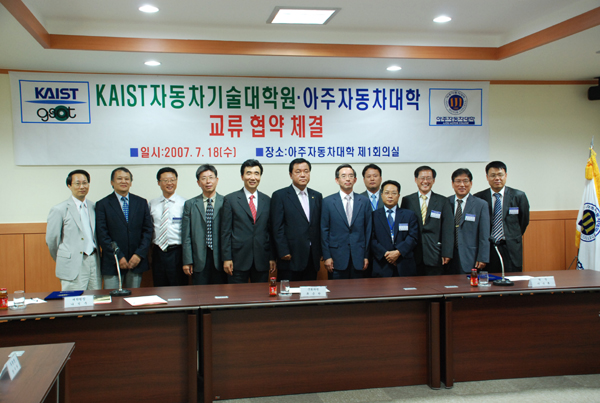 Cooperation Agreement with Ajou Motor College
Cooperation Agreement with Ajou Motor College
KAIST Graduate School of Automobile Technology to sign a cooperation agreement with Ajou Motor College
KAIST Graduate School of Automobile Technology (GSAT) signed a cooperation agreement with Ajou Motor College (AMC) on July 18th.
Under the agreement, the both schools will share education and research facilities and promote mutual cooperation for joint education and researches.
Lawmaker Geun-Chan Ryu, KAIST Vice President of Budget & Planning Ji-Won Yang, GSAT Dean Suck-Joo Na, AMC Dean Soo-Hoon Lee, etc. attended the ceremony.
2007.07.24 View 16934
Cooperation Agreement with Ajou Motor College
Cooperation Agreement with Ajou Motor College
KAIST Graduate School of Automobile Technology to sign a cooperation agreement with Ajou Motor College
KAIST Graduate School of Automobile Technology (GSAT) signed a cooperation agreement with Ajou Motor College (AMC) on July 18th.
Under the agreement, the both schools will share education and research facilities and promote mutual cooperation for joint education and researches.
Lawmaker Geun-Chan Ryu, KAIST Vice President of Budget & Planning Ji-Won Yang, GSAT Dean Suck-Joo Na, AMC Dean Soo-Hoon Lee, etc. attended the ceremony.
2007.07.24 View 16934